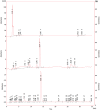Recovery and partial isolation of ⍺-mangostin from mangosteen pericarpsvia sequential extraction and precipitation
- PMID: 39453921
- PMCID: PMC11508469
- DOI: 10.1371/journal.pone.0310453
Recovery and partial isolation of ⍺-mangostin from mangosteen pericarpsvia sequential extraction and precipitation
Abstract
This study introduced an innovative sequential extraction methodology designed for the efficient recovery of alpha-mangostin (⍺-M) from mangosteen pericarps. Alpha-mangostin, renowned for its pharmacological properties including anti-inflammatory, anti-cancer, and anti-bacterial effects, has garnered significant attention across diverse industries. The proposed method of sequential extraction achieved 73% recovery and a yield of 46.75 mg/g based on the weight/weight percentage of the mass of ⍺-M extracted from the sequence and the mass of raw material. Furthermore, the purity of the dried product was 67.9%. The sequence solvent extraction system, comprising water, hexane, and acetonitrile, plays a pivotal role in enhancing the efficacy of the extraction process. Notably, this methodology offers a cost-effective alternative to conventional extraction methods. It reduces the need for complex equipment and processes, positioning it as a resource-efficient extraction technique in comparison to existing methodologies. This novel sequential extraction method presents a promising avenue for the economical and sustainable recovery of alpha-mangostin (⍺-M) from pericarps.
Copyright: © 2024 Han et al. This is an open access article distributed under the terms of the Creative Commons Attribution License, which permits unrestricted use, distribution, and reproduction in any medium, provided the original author and source are credited.
Conflict of interest statement
The authors have declared that no competing interests exist.
Figures







References
-
- Adriani L., Widjastuti T., Nurdianti R.R., and Wiradimadja R., Effects of mangosteen peel extract (Garcinia mangostana L.) on blood lipid of ntiox chicken growth phase. In Proceedings of the 3rd International Conference of Integrated Intellectual Community (ICONIC), Hannover, Germany, 27–29 April 2018; pp. 1–5.
-
- Charoenphun N., Setarnawat S., and Sai-Ut S., Chemical composition and trends in utilization of by-products and wastes from 4 types of tropical fruit processing. TJST, 2020. 28: p. 113–128.
-
- Mello R.F.A., Pinheiro W.B.S., Benjamim J.K.F., Siqueira F.C., Chiste R.C., and Santos A.S., A fast and efficient preparative method for separation and purification of main bioactive xanthones from the waste of Garcinia mangostana L. by high-speed countercurrent chromatography. Arab. J. Chem., 2021. 14: p. 103252.
-
- Widowati W., Ginting C.N., Lister N.E., Gisang E., Amalia A., Wibowo S.H.B., et al.., Anti-aging effects of mangosteen peel extract and its phytochemical compounds: Antioxidant activity, enzyme inhibition and molecular docking simulation. Trop. Life Sci. Res., 2020. 31: p. 127–144. doi: 10.21315/tlsr2020.31.3.9 - DOI - PMC - PubMed
-
- Chaiwong N., Phimolsiripol Y., Leelapornpisid P., Ruksiriwanich W., Jantanasakulwong K., Rachtanapun P., et al.., Synergistics of carboxymethyl chitosan and mangosteen extract as enhancing moisturizing, antioxidant, antibacterial, and deodorizing properties in emulsion cream. Polymers, 2022. 14: p. 178. doi: 10.3390/polym14010178 - DOI - PMC - PubMed
MeSH terms
Substances
LinkOut - more resources
Full Text Sources

